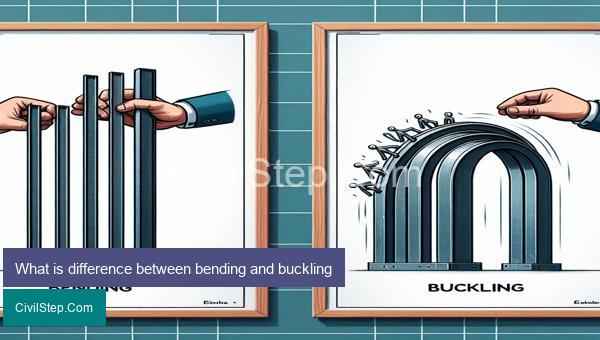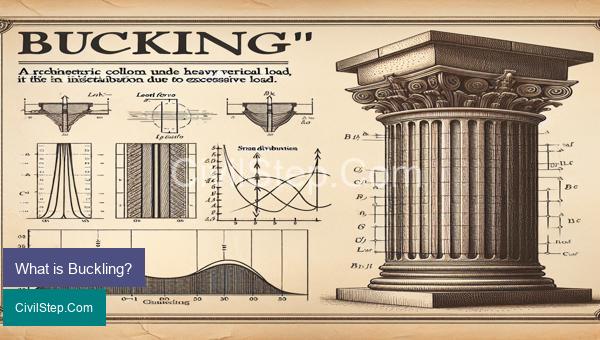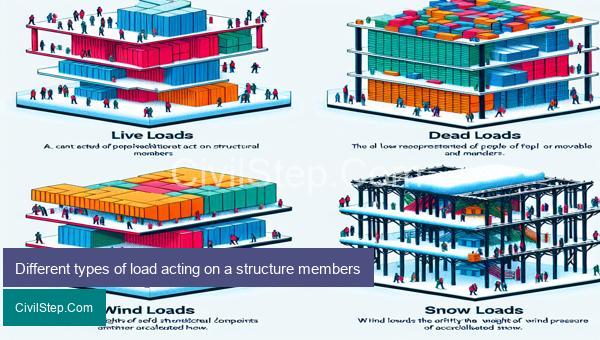
Bending and buckling are two fundamental mechanics of materials concepts that play a crucial role in many engineering and construction projects. These two phenomena describe the deformation of a material under applied loads, which is essential to understand in order to design structurally sound and safe structures. Whether it’s a bridge, a skyscraper, or a simple beam, all structures are subjected to bending and buckling forces, making it imperative for engineers and designers to have a thorough understanding of these concepts. In this article, we will delve into the basics of bending and buckling, their causes, and how they can be prevented or controlled in various structural systems. So, let’s explore the world of bending and buckling and gain a better understanding of these important concepts.
What is difference between bending and buckling

Bending and buckling are two fundamental concepts in structural engineering that refer to the behavior of loaded beams or columns. Both bending and buckling are caused by a compressive force applied to a structural member, but they have distinct characteristics and consequences.
Bending occurs when a structural member is subjected to a force that causes it to deform and bend along its length. The applied force creates a moment, or a force that causes rotation, at any point along the beam or column. This moment causes the top and bottom portions of the member to experience compression and tension, respectively. As a result, the member will experience a curvature along its length, commonly referred to as deflection. Bending is the most common and expected response of a structural member to a compressive force.
On the other hand, buckling is a more serious failure mechanism that occurs when a structural member is subjected to a compressive force beyond its capacity. In this case, the applied force causes the member to buckle, or suddenly bend out of its original straight position, causing a catastrophic failure. Buckling is often described as the overall lateral deflection of a member, and it is characterized by a sudden, unstable failure mode. Unlike bending, which can be easily predicted and accounted for in the design, buckling is more difficult to predict and can have devastating consequences.
In summary, the main difference between bending and buckling is the response of a structural member to compressive forces. Bending is a desirable and expected behavior, while buckling is an undesirable and potentially hazardous failure mode. While bending can be predicted and mitigated through proper design techniques, buckling must be carefully considered and avoided in order to ensure the structural integrity and safety of a building or other structure.
What is bending?

Bending is a fundamental concept in civil engineering and it refers to the deformation of a structural member when a load is applied to it. It is a type of stress that causes a structural member to bend or flex, hence changing its shape. Bending can occur in various structures such as beams, columns, slabs, and trusses.
In simpler terms, bending can be defined as the change in shape of a structural member due to a moment or force acting on it. This type of stress is commonly seen in bridges, buildings, and other structures that are subjected to vertical loads, such as the weight of people, furniture, snow, or wind.
The process of bending involves two main components: compression and tension. When a load is applied to a structural member, it causes compression on one side and tension on the other. Compression is the force that squeezes the material while tension is the force that pulls it apart. As a result, the material in the compression zone gets shortened while the material in the tension zone gets elongated, causing the structural member to bend.
Bending can be either elastic or plastic. In elastic bending, the structural member returns to its original shape after the load is removed. This is typically seen in temporary structures or objects made of more flexible materials like rubber or plastic. On the other hand, plastic bending occurs when the load exceeds the material’s strength, causing permanent deformation. This is common in permanent structures where the material is able to sustain a certain amount of deformation before failure occurs.
To design a structure that can withstand bending, civil engineers must consider the maximum amount of bending stress a material can handle without failure. This is known as the flexural strength of a material and it is determined through extensive testing in a laboratory.
In structural design, engineers use various techniques to minimize bending. This can be achieved by selecting the appropriate cross-sectional shape and size of the structural member, using materials with high flexural strength, and providing additional support through reinforcements.
In conclusion, bending is an essential concept to consider in civil engineering as it plays a crucial role in the stability and safety of structures. It is a result of the interaction between different forces and materials, and proper understanding of bending is necessary for the successful design and construction of structures.
What is Buckling?

Buckling is a phenomenon that occurs when a structural member, such as a column or a beam, becomes unstable and fails under compressive stress. It is a critical design consideration in civil engineering, as it can significantly impact the safety and structural integrity of a building or structure.
Buckling is a form of structural failure caused by excessive compressive stress, which results in a sudden lateral deflection or bending of the member. This deflection usually happens in the direction perpendicular to the axis of the applied compressive load.
The point at which buckling occurs is known as the critical load, and it is influenced by various factors such as material properties, geometry and boundary conditions of the structural member. When the applied load exceeds the critical load, the member will suddenly deflect laterally, leading to structural failure.
One of the most common types of buckling is Euler buckling, which occurs in long and slender columns or beams. It is named after the Swiss mathematician Leonhard Euler, who first described it in the 18th century. Euler buckling happens when the length of the structural member is significantly longer than its cross-sectional dimension.
Other types of buckling include torsional buckling, local buckling, and lateral-torsional buckling. Torsional buckling happens in thin-walled members under torsional loading, whereas local buckling occurs when a localized section of the member fails due to high stresses. Lateral-torsional buckling, on the other hand, is a combination of both lateral and torsional buckling.
Buckling can also be influenced by imperfections or irregularities in the structural member, as these can weaken its ability to resist compressive load. Examples of imperfections include initial curvatures, residual stresses, and out-of-straightness.
To prevent buckling, engineers take various measures during the design and construction phase. These include selecting appropriate materials with high compressive strength, using stiffening members such as bracings or struts, and ensuring proper column bracing and restraint against lateral movements. Additionally, structural analysis and calculations are performed to determine the critical load and identify any potential issues before construction begins.
In conclusion, buckling is a significant concern in civil engineering, and its consequences can be catastrophic if not properly addressed. It is crucial for engineers to understand the factors that influence buckling and to take necessary measures to prevent it in structural designs to ensure the safety and stability of buildings and structures.
What is difference between bending and buckling

Bending and buckling are two fundamental concepts in structural engineering that refer to the behavior of loaded beams or columns. Both bending and buckling are caused by a compressive force applied to a structural member, but they have distinct characteristics and consequences.
Bending occurs when a structural member is subjected to a force that causes it to deform and bend along its length. The applied force creates a moment, or a force that causes rotation, at any point along the beam or column. This moment causes the top and bottom portions of the member to experience compression and tension, respectively. As a result, the member will experience a curvature along its length, commonly referred to as deflection. Bending is the most common and expected response of a structural member to a compressive force.
On the other hand, buckling is a more serious failure mechanism that occurs when a structural member is subjected to a compressive force beyond its capacity. In this case, the applied force causes the member to buckle, or suddenly bend out of its original straight position, causing a catastrophic failure. Buckling is often described as the overall lateral deflection of a member, and it is characterized by a sudden, unstable failure mode. Unlike bending, which can be easily predicted and accounted for in the design, buckling is more difficult to predict and can have devastating consequences.
In summary, the main difference between bending and buckling is the response of a structural member to compressive forces. Bending is a desirable and expected behavior, while buckling is an undesirable and potentially hazardous failure mode. While bending can be predicted and mitigated through proper design techniques, buckling must be carefully considered and avoided in order to ensure the structural integrity and safety of a building or other structure.
Different types of load acting on a structure members

Structural members, such as beams, columns, and walls, are designed to resist different types of forces and loads that act upon them. These loads can be broadly classified into two categories: dead loads and live loads. Dead loads are permanent loads that remain constant over time, while live loads are variable loads that change in magnitude and location.
The following are the different types of loads acting on structural members:
1. Self-weight or Dead Load: This is the weight of the structural member itself, including any permanent fixtures or finishes such as walls, floors, roofs, and beams. The dead load acts vertically downwards and remains constant throughout the life of the structure.
2. Live Load: Also known as imposed loads, these are temporary loads that vary in magnitude and location. Examples include the weight of people, furniture, vehicles, wind, rain, snow, and any moveable loads on a structure.
3. Snow Load: In areas that experience heavy snowfall, the weight of accumulated snow on a structure can cause significant stresses. The amount of snow load a structure can withstand depends on factors such as location, shape, and slope of the roof.
4. Wind Load: As the name suggests, wind load is the force exerted by the wind on a structure. It is an important consideration in the design of tall and exposed buildings. The magnitude of wind load depends on factors such as wind speed, direction, and turbulence.
5. Seismic Load: In regions prone to earthquakes, structures must be designed to withstand the horizontal and vertical forces caused by ground motion. The severity of seismic load depends on factors such as the location of the structure, building material, and foundation type.
6. Thermal Load: Temperature changes can cause expansion or contraction of structural members, leading to internal stresses. This load is significant in structures with a large exposed surface area, such as bridges and pipelines.
7. Impact Load: Occurring suddenly and with high intensity, impact loads are caused by the sudden application of a concentrated force, such as a moving vehicle or a falling object. These loads can cause deformation, cracking, and structural failure if not considered in the design.
8. Earth Pressure: Structures built into the ground, such as retaining walls, basements, and tunnels, experience lateral forces from the soil surrounding them. This type of load is known as earth pressure and must be carefully considered in the design to prevent structural failure.
9. Fluid Pressure: Structures built to hold or redirect fluids, such as dams, water tanks, and pipelines, are subjected to fluid pressure. This load is caused by the self-weight of the fluid and the effect of any fluid motion, such as water flow or wind-induced waves.
10. Construction Load: During the construction phase, a structure may experience temporary loads from equipment, materials, and workers. These loads must be carefully considered and controlled to prevent any damage to the structure.
In conclusion, understanding the different types of loads acting on a structure is crucial in the design process to ensure its safety and durability. Each type of load requires careful consideration and analysis to determine its magnitude and effect on the structural member and to select the appropriate design and materials to withstand these loads.
Conclusion
In conclusion, understanding the concepts of bending and buckling is crucial in engineering and construction. Bending is the deformation of a material due to an applied load, while buckling is the sudden failure of a structural component under compressive stress. Both phenomena have significant implications for the safety and performance of structures, making it essential to design and analyze them effectively. By considering factors such as material properties, boundary conditions, and loading conditions, engineers can effectively mitigate the risks of bending and buckling in their designs. It is also vital to regularly monitor and maintain structures to prevent unforeseen failure due to these phenomena. Thus, a thorough understanding of bending and buckling is essential for creating safe and durable structures.
